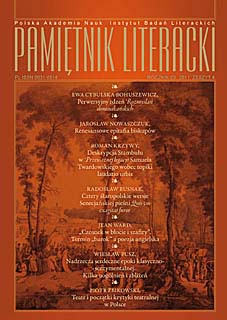Cztery staropolskie wersje Senecjańskiej pieśni „Quis vos exagitat furor”
Four Old-Polish Versions of Seneca’s Song „Quis Vos Exagitat
Furor”
Author(s): Radosław RusnakSubject(s): Literary Texts
Published by: Instytut Badań Literackich Polskiej Akademii Nauk
Keywords: Seneca’s “Thyestes;” Seneca’s song „Quis Vos Exagitat Furor;” Seneca’s song translations; Jan Alan Bardziński; Józef Epifani Minasowicz; Jan Rybiński; Jan Andrzej Morsztyn; Morsztyn’s “Votum z Seneki"
Summary/Abstract: The author presents the ideological matter of the second stasimon of Seneca’s “Thyestes,” which contains stoic knowledge about “true reign” seen as masterly control of one’s passions connected with divesting of flighty ambitions and fears, the latter including those related to imminent death. Considering the universal, comprehensively sketched role model and its literary form, the ancient monody “Quis vos exagitat furor” over a span of centuries looses its integral connectivity with Mycenaean infanticide drama and becomes a subject of faithful translations and creative adaptations. Seneca’s song in Poland were translated by Jan Alan Bardziński and Józef Epifani Minasowicz, while Jan Rybiński and Jan Andrzej Morsztyn produced its original adaptations. A close analysis of Morsztyn’s “Votum z Seneki (Lutnia 57)” gives way to see it as an alternative source of Old-Polish apology of life in seclusion to Horace’s famous epode “Beatus ille.”
Journal: Pamiętnik Literacki. Czasopismo kwartalne poświęcone historii i krytyce literatury polskiej
- Issue Year: 2011
- Issue No: 4
- Page Range: 59-79
- Page Count: 21
- Language: Polish

